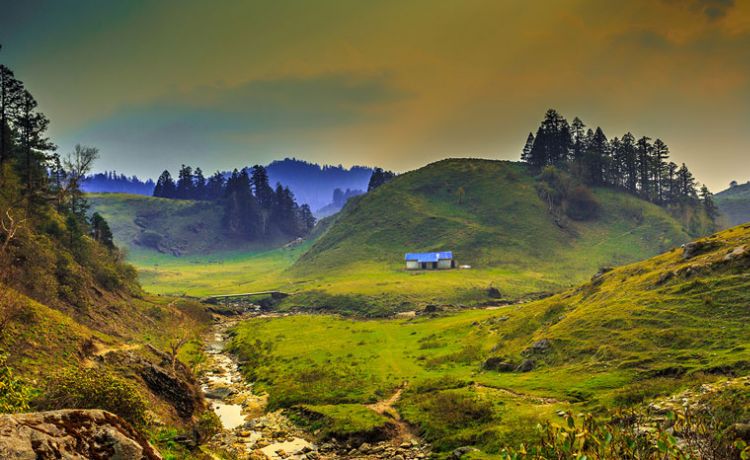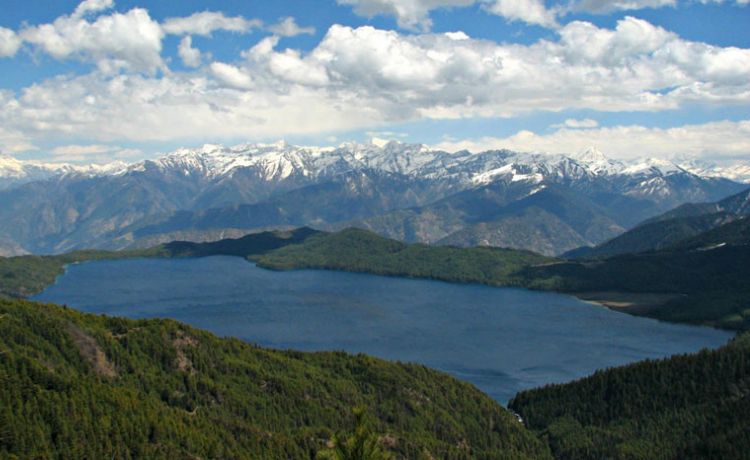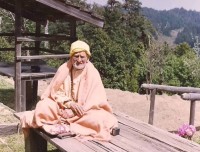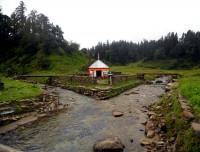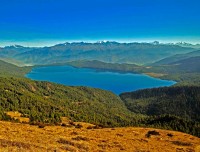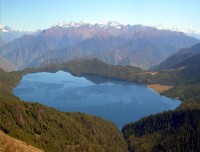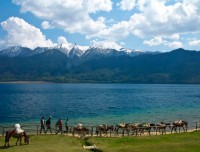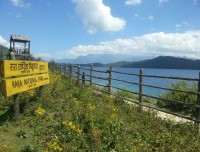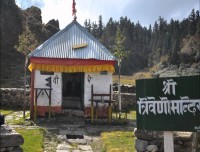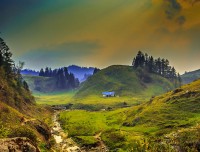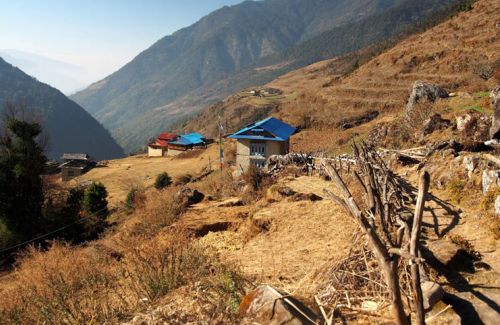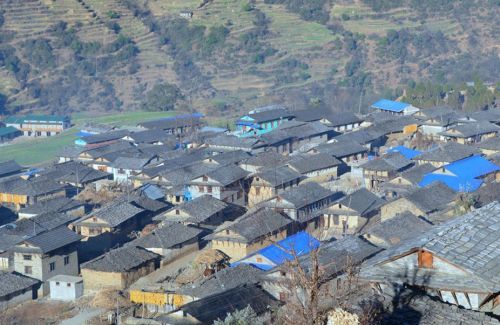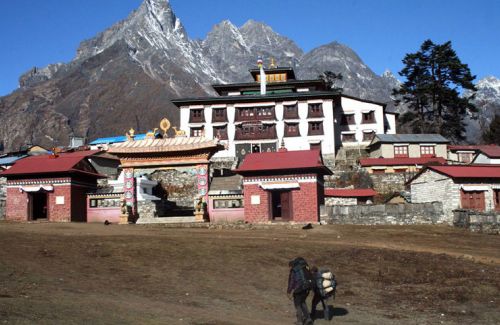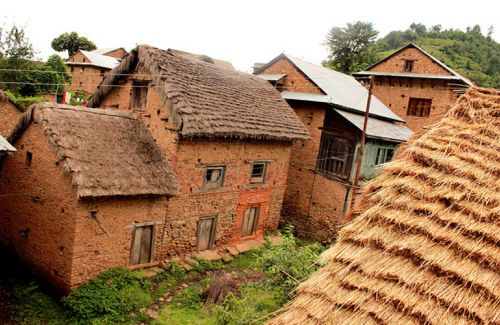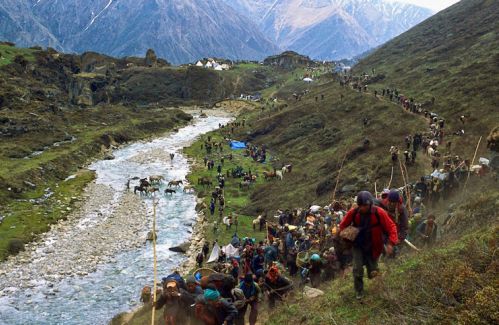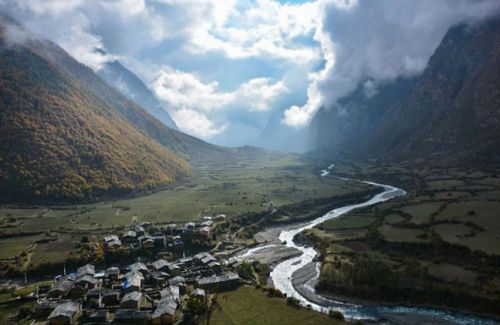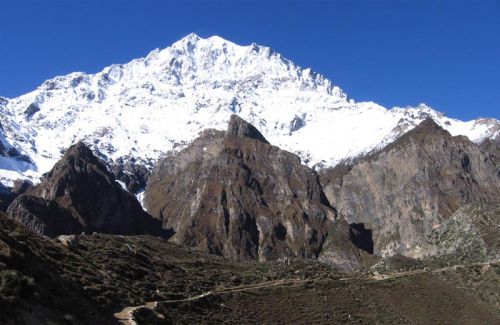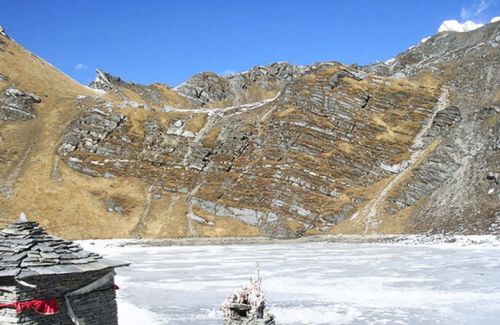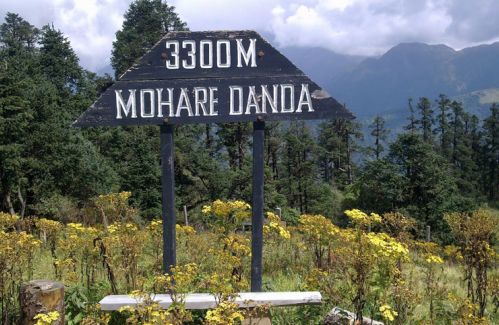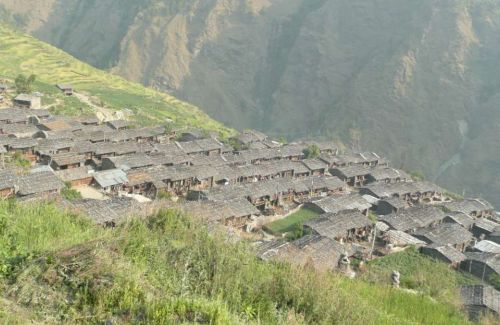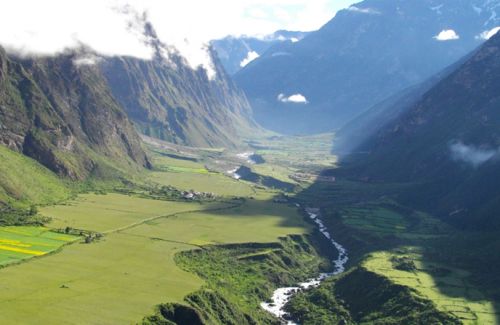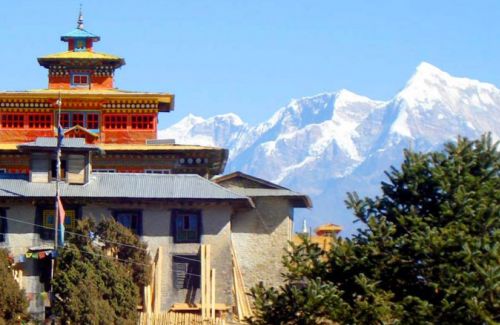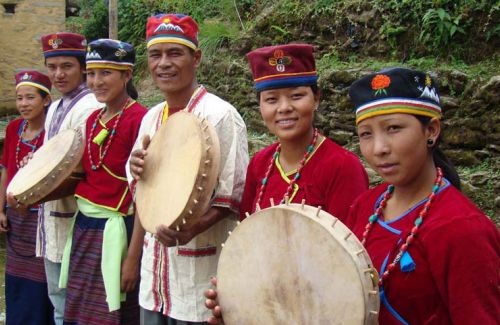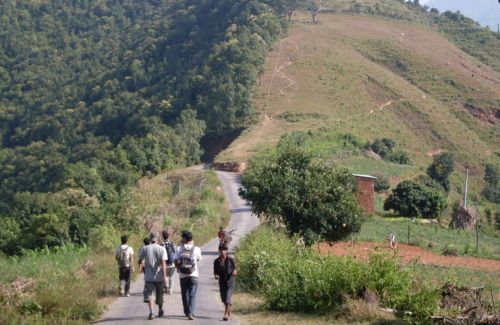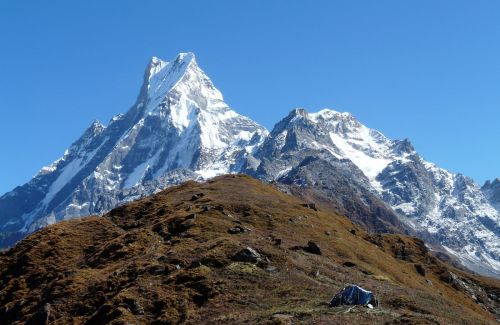Rara Khaptad Circuit Trekking
- Duration19 Days
- Max. Altitude3,157 m
- Starts FromUSD 3180
Destination:Nepal
Trip Grade:Strenuous (****)
Meals:Breakfast + Lunch + Dinner
Transportation:Private Vehicle / Aeroplane
Accommodation:Camping
Trekking Region:Rara Lake - Khaptad
Show AllRara National Park and Khaptad National Park are two important protected sites in Mid and Far- Western Nepal. Rara Khaptad Circuit Trekking aims to link two tourist destinations of Nepal that are still in shadow despite having immense potential. Rara Khaptad Circuit Trek begins with a flight to Talcha Airport in Mugu from Nepalgunj which is easily accessible from Kathmandu via land and aerial routes.
We begin our trek Rara Khaptad from Rara Lake. Rara Lake is the biggest lake with its wonderful beauty, reflecting the images from the nearby towering mountains and thick pine forests in its crystal clear water. Khaptad is rich in diverse landscape with rolling green hills, moorlands, steep slopes, streams and meadows. There are 567 species of vegetation including rhododendron,oak,pine found in this protected area. We can view Api and Saipal Himalayan ranges from here.
Khaptad is great for spotting wildlife and birds, with 23 species of mammals and 287 types of birds. Mammal species of the park are leopard, Himalayan black bear, wild dog and musk deer. Bird species include the beautiful Impeyan pheasant (danphe; Nepal’s national bird), Peregrin falcon, the white rumped vulture and many types of partridges, flycatchers, bulbuls, cuckoos and eagles.
You could go into the wild and venture through thick forests, alpine landscapes and Nepal’s countryside with remote mountain villages which have hardly seen any tourists. A perfect trek for the adventurer looking for a real wilderness experience.
Trip Highlights
- Day Sightseeing at World Heritage Sites in Kathmandu
- Scenic flight from Kathmandu to Nepalgunj and Nepalgunj to Talcha Airport
- Drive back from Dhangadhi to Kathmandu
- Explore around Rara Lake and enjoy its pristine beauty
- View the towering mountains view of far western region
- Khaptad National Park and its rich flora and fauna
- Visit the place where people go for pilgrimage purpose
- Unique Far - Western culture and ways of living
Day to Day Itinerary
Day 01:Arrival In Kathmandu Airport (1350 m) and Transfer to Hotel. Overnight at Hotel
Day 02:Pre-Trip Meeting and Sightseeing at World Heritage Sites. O/N at Hotel
Day 03:Flight from Kathmandu to Nepalgunj, 50 mins.O/N at Hotel
Day 04:Flight from Nepalgunj to Talcha (2,645 m) & trek to Rara Lake, 4 hrs. O/N at Camp
Day 05:Excursion around Rara Lake (2990 m). O/N at Tented Camp
Day 06:From Rara Lake to Serkot (2500 m), 5-6 hrs. O/N at Tented Camp
Day 07:From Serkot to Jugala (1600 m), 5-6 hrs. O/N at Tented Camp
Day 08:From Jugala to Kolti (1300 m), 5-6 hrs. O/N at Tented Camp
Day 09:From Kolti to Parekh Lekh (2700 m),5-6 hrs. O/N at Tented Camp
Day 10:From Parekh Lekh to Martadi (1897 m), 4-5 hrs. O/N at Tented Camp
Day 11:From Martadi to Dhuralsen (1625 m), 5 hrs. O/N at Tented Camp
Day 12:From Dhuralsen to Laske Chaur (2060 m), 5-6 hrs. O/N at Tented Camp
Day 13:From Laske Chaur to Khaptad (3157 m), 5-6 hrs. O/N at Tented Camp
Day 14:Day exploration around Khaptad. O/N at Tented Camp
Day 15:From Khaptad to Simalpani (1500 m), 6 hrs. O/N at Tented Camp
Day 16:From Simalpani toTamil (1130 m), 2 hrs. O/N at Lodge
Day 17:From Tamil to Dhangadi (109 m), 10 hrs. O/N at Hotel
Day 18:Drive from Dhangadi to Kathmandu (1350 m), 12 hrs. O/N at Hotel
Day 19:Transfer to International Airport
Cost Include
- Airport picks up & drops off by private tourist vehicle
- 3 nights’ in Kathmandu and 1 night in Nepalgunj, 2-3 star hotels with Breakfast
- Guided city tour in Kathmandu by private tourist vehicle
- A government licensed holder city tour guide
- Full board meals (Breakfast + Lunch + Dinner) during the trek
- Lodges, Guesthouses, Camping accommodation during the trek
- Professional license holder English speaking Trekking Guide
- The required number of local staff and porters (2 Trekkers = 1 Porter)
- Food, accommodation, salary, insurance, equipment and medicine for all staff
- Rara - Khaptad National Parks Entry permit and TIMS permit for trekking
- Down Jacket, Duffle bag and sleeping bag by Himkala Adventure if required
- All the required things for the tented camping by Himkala Adventure
- Airfare from Kathmandu to Nepalgunj and Nepalgunj to Talcha
- Drive from Dhangadhi to Kathmandu by public transportation
- Farewell Dinner in traditional Nepali restaurant with cultural show
-
Government Taxes, VAT,and Service Charge
Cost Exclude
- Lunch and dinner in Kathmandu
- Entrance fee in all monuments during tour
- Emergency Rescue and Evacuation cost
- Your travel insurance
- Nepal entry visa fee
- Personal expenses like hot shower, battery recharge, hot and cold drinks etc
- Personal trekking equipment
- Tips for trekking, tour staff and driver (Tipping is expected)
-
Any others expenses which are not mentioned on ‘Cost Includes' section
Detail Itinerary
Day 01Arrival In Kathmandu Airport (1350 m) and Transfer to Hotel. Overnight at HotelAfter you land at Tribhuvan International Airport in Kathmandu, you pass through the passage where you could see the placards on the wall which identify the Nepal’s monuments, history, resources, and come to the custom clearance section. After the custom formalities, you will come out of the entrance. Our representative from Himkala Adventure heartily greets you and transfers you to the hotel. Overnight at Kathmandu
Day 02Pre-Trip Meeting and Sightseeing at World Heritage Sites. O/N at Hotel Today, we have planned to visit historical monuments of Kathmandu listed in World Heritage Sites. First, we will visit the monkey temple. This is in fact the Buddhist stupa, built in Tibetan architecture. The 6th century old stupa and the monastery in its premises on the top of the hill are remarkable. After this, we go to Kathmandu Durbar Square where we visit The Kumari Ghar – The living goddess, many courtyards, palace, museum, Hindu temples. The art and architecture is fabulous. The Boudha stupa has been surrounded by houses and monasteries give different serene atmosphere. The scene from the roof top restaurant, walking monks around chanting mantra, looks full of spirituality. Finally, we visit the famous Hindu Shiva temple which is situated on the bank of holy Bagmati River. There we can see the cremation spot where the dead bodies are being cremated. After this, we return back to hotel and brief you about the Rara-Khaptad Trekking that we start from tomorrow. Overnight at Kathmandu
Day 03Flight from Kathmandu to Nepalgunj, 50 mins.O/N at Hotel We fly from Kathmandu to Nepalgunj which is 50 minutes flight. There are few good hotels as well. We can walk around there and visit Bageshwori Temple, Shiva Temple. We can visit the Rupaidiya, bordering town by taking the horse carriages. Overnight at Nepalgunj
Day 04Flight from Nepalgunj to Talcha (2,645 m) & trek to Rara Lake, 4 hrs. O/N at Camp Today, we fly from Nepalgunj to Talcha Airstrip of Mugu early in the morning. This is 45 minutes flight which offers an amazing landscape view of the mid-western region. There are about 5 hotels near Talcha airstrip and some are under construction. After getting breakfast, we begin our trek to Rara Lake. We can see the changes in landscape and vegetation after an hour walk then another after an hour; we can view the Rara Lake. The nearer we approach; the more changing color of Rara Lake seems fascinating. There is only one hotel on the bank of the Rara Lake but we could spend this night in the tented camp. Overnight at Rara Lake
Day 05Excursion around Rara Lake (2990 m). O/N at Tented Camp Rara is the largest Lake in Nepal. We can walk around the lake and go for short hike to Murmatop to enjoy the best view of Rara. From this top, we can see the Kanjirowa Mountains too. It would be good idea to take packed lunch because there are no hotels on the way to Murmatop. It takes about 3-4 hours passing through the small village. We can enjoy the sunset while going downhill. The moonrise and stars reflecting in the pristine water of Rara is overwhelming. The conifer forest around the lake is beautiful. The place is rich with Himalayan herbs. Overnight at Rara Lake
Day 06From Rara Lake to Serkot (2500 m), 5-6 hrs. O/N at Tented Camp Today, we walk downhill to the Khaytad following the Khaytad River. After an hour, we reach to Majghat (2,374 m). After leaving Majghat, we further descend to Murma where there are big pasturelands. People are seemed in traditional attire, speaking native language and smoking homegrown tobacco in their hookah. From there, it takes about two hours to reach to Jhaudi Khola. We take our lunch there and continue our trek to Bapani (2,528 m). This is the small settlements of Brahmin and Chhetries. After passing village Jam (2,173 m) through Nibalbot (2,410 m) and Masane, we arrive at Serkot. Overnight at Serkot
Day 07From Serkot to Jugala (1600 m), 5-6 hrs. O/N at Tented Camp Today, we walk from Serkot to Ranakot then reach to Upper Kharka, Lower Kharka and Khadgi Mela to Majchaur (1,825 m). Majchaur has few hotels and tea shops. From Majhchaour, we reach to Paukipani (1,668 m) after an hour. From Paukipani, we arrive at Bira Bagar (1,527 m) which takes an hour from Paukipani. We take our lunch here and head towards Jamisera. After crossing many suspension bridges, and come across waterfalls cascading down the hills into the river. We walk about 2 hours through Ratapani and arrive at Ama Village. After half an hour walk from Ama village takes us to Rega Village. We can see the Karnali River from here. The khaytad Khola which we had followed for about 3 days meets Karnali River in this village. After an hour along the Karnali River, we arrive at Jugala. Overnight at Jugala
Day 08From Jugala to Kolti (1300 m), 5-6 hrs. O/N at Tented Camp After breakfast, we cross the suspension bridge over the Karnali River and enter Bajura District. After an hour walk from Jugala, we reach to Chepi (1,209 m). Chepi is the small village situated on the bank of Karnali River. After 45 minutes from Chepi, we arrive at Kurane Jugala (1,119 m). After the trek of about 2 hours from Kurane Jugala, we arrive at Alange Chaur (1,082 m). After 45 minutes walk from Alage Chaur, we reach to Chulighat Badhu where we get our lunch. We continue our trek along the Karnali River through Chuli Gadh and Badhu Bagar (1,134). After Badhu Bagar, we walk 2 hours following the bank of Kundana River then arrive at Partola (1,208 m) via Badhu Metala (1,240 m) Pipal Dali (1,293 m), and Raut Badhu. It takes half an hour from Partola to reach to Kolti. Overnight at Kolti
Day 09From Kolti to Parekh Lekh (2700 m),5-6 hrs. O/N at Tented Camp After breakfast, we walk uphill passing through Kumarkot (1,466 m), Ser Katiya, Samal and Ananda Nagar. From Ananda Nagar, we arrive at Pandusen (2,044m) through Pirekot (1,936 m). We get lunch here. Pirekot is the commercial center inhabited by Brahmins, Chhetris and Sherpas. After lunch at Pandursen, the trek passes through Chadi Pani (2,204 m) Angau Pani (2,302m ) and Paurekhe Khad (2,544 m). After an hour from Paurekhe Khad, we reach the Parekh Lekh hilltop (2700 m). Overnight at Parekhi Lekh
Day 10From Parekh Lekh to Martadi (1897 m), 4-5 hrs. O/N at Tented Camp After breakfast, we go uphill until we reach to Pugi Dami. The trail passes through dense forest downhill till Damkane (2,339 m). It is about 3 hours trek from Damkane to Chuti . After lunch, we trek downhill along the Budhi Nandi River to Martadi (1,897 m). Martadi is the main market for four districts – Bajura, Bajhang, Doti and Accham.Overnight at Martadi
Day 11From Martadi to Dhuralsen (1625 m), 5 hrs. O/N at Tented Camp After Martadi, we reach to Goatwall Bata from where we follow the Bauli River to reach Saleghat (1,362 m). It takes half an hour from Saleghat to Rapak (1,308 m). After an hour walk from Rapak, we can reach to Bire Khola (1,292 m). We can see the waterfall on the way to Jadanga (1,165m) after half an hour walk from Kurdali Ghat. Jadanga is a small valley surrounded by the hill around. From Jadanga, we cross the suspension bridge over the Budhi Ganga and reach to Tiphad Bazaar (1,118 m). We ascend about an hour to reach Amakhot (1,261m). From Amakhot, we walk about one and half an hour passing through beautiful village, then arrive at Dhralsen (1,625 m). Overnight at Dhuralsen
Day 12From Dhuralsen to Laske Chaur (2060 m), 5-6 hrs. O/N at Tented Camp Today, after breakfast, we walk through dense forest and reach to Khudi Village after an hour. We continue to trek to Surkha Bazaar, known as Atichaur which takes an hour from Khudi Village. We follow the trek along Dhane Bagar Khola and reach to Bade Bada (1,974 m) via Oli Gaun.We cross Dhane Bagar Khola and arrive at Chede Daha (2,159 m). After an hour walk from Chede Daha takes us to Dogadi Village. We take lunch here and continue the trek to Tham (2,183 m) through Rampur (2,053 m). Guliya Chaur is the pastureland, we reach passing through dense forest from Rampur. It is an hour trek from Guliya Chaur which takes us to Laske Chaurwhic h lies inside the Khaptad National Park. Overnight at Laske Chaur
Day 13From Laske Chaur to Khaptad (3157 m), 5-6 hrs. O/N at Tented Camp It is the trek through the dense forest inside the Khaptad National Park. We get an opportunity to see many wild animals and species of birds. After climbing uphill an hour, we reach to Top (3,033 m). It takes 30 minutes to reach Bhalaune Patan (3,123 m), the big grassland. After an hour walk from Bhalaune Patan, we reach to Pulpule (3,173 m). After lunch, we continuously walk about 3 hours to reach the headquarters of the Khaptad National park through grasslands. Overnight at Khaptad
Day 14Day exploration around Khaptad. O/N at Tented Camp We can enjoy the day around Khaptad visiting the Park headquarters. There is the famous Khaptad Baba Ashram and the temples of Shiva and Ganesh. The temples of Nagdhunga and Kedardhunga in Tribeni are worth visiting. Overnight at Khaptad
Day 15From Khaptad to Simalpani (1500 m), 6 hrs. O/N at Tented Camp After breakfast, we begin our trek from Khaptad to Simalpani. We walk through the dense forest about an hour and continue to trek to Lekhda (2,493 m) which takes about 2 hours from the headquarters. After an hour from Lekhda, we arrive at Lamtada via Meltadi (1,882 m). We take our lunch at Lamtada. After lunch, we cross Sunar Village following an irrigation canal. We arrive at Fulbari after one and half hours walk from Sunar Village via Jimkot (1,456 m). We finally reach to Simalpani. Overnight at Simalpani
Day 16From Simalpani toTamil (1130 m), 2 hrs. O/N at Lodge After breakfast, we walk from Simalpani to Tamil. After 2 hours walk from Simalpani through Jadri Ghat, Aaucheli Bagar, Tala Bagar, Khati and Khairadi, we rach to Tamil. There is a regular bus service to different parts of the country. Overnight at Tamil
Day 17From Tamil to Dhangadi (109 m), 10 hrs. O/N at Hotel We drive from Tamil to Dhangadi. It takes about 10 hours to reach Dhangadi. Dhangadhi has number of good hotels and lodges. Overnight at Dhangadhi
Day 18Drive from Dhangadi to Kathmandu (1350 m), 12 hrs. O/N at Hotel We can fly from Dhangadi to Kathmandu. It is one hour 20 minutes flight from Dhangadhi to Kathmandu. There is a regular bus service as well. It is 723 km from Dhangadhi to Kathmandu which takes about 12 hours to drive. When we arrive in Kathmandu, we check in hotel and take rest for a while. We will be together for the dinner with Nepalese Cultural Show. Overnight at Kathmandu
Day 19Transfer to International Airport We transfer you to the airport 3 hours before your scheduled flight. If you would have enough time, you could go for shopping in the local market in Kathmandu. Collecting the memories of your trek to Rara Khaptad region, you are going to the next destination and we are obliged to you that you joined Himkala Adventure. We wish you have safe journey. Namaste!!!
Trip FAQ
Himkala Adventure would like to answer all the queries about Rara Khaptad Circuit Trekking for all curious travelers/trekkers in the world. As you are entirely from different geographical location, you could better to know everything about the treks from the beginning i.e. airport pick up till your departure like airport picks up, drops off, accommodation in city, in the trek, guide and porters, safety for the trekking, food and accommodation and some other things that you might face on the way. Hope our endeavor listing these questions answers will help you self informed.
This is simply the outlines of the services we offer but it may differ as per your requirement, number of trekkers. What we go through our conversation, we will manage the means of transportation, hotels in the city, accommodation in the trekking, numbers of porters etc. This is general idea about Rara Khaptad Circuit Trekking before your trip and you become clearer about the trek. Please feel free to contact us to get more information about the trekking in the Himalayas of Nepal.
1) What physical fitness do I need to book this trip?
Every trekking in the Himalayas of Nepal requires the certain level of physical and mental fitness. So, we advise you to be in good physical shape and able to feel comfortable while hiking up and down 7 to 12 miles per day on a trail carrying a day pack of about 10 pounds. Three things could make you confident enough for any trek you would like to do: aerobic, strength and mental.
Aerobic conditioning is important primarily because you will be trekking in thinner air, up to 40% less than at sea level. With good aerobic conditioning, you will be able to better metabolize whatever oxygen is available to you. You should plan on doing at least one hour of aerobic 3 /4 times per week for 1 month or more before your arrival in Nepal. Walking, jogging, cycling, hiking on valley floor to ridge line ascents with day back are some of the excellent forms of exercise, so long as you are strengthening leg muscles and building stamina. Speed is not the essence; stamina, confidence and continuity are. Do as much uphill as possible. If you live in flat area, go to the stadium and use the steps with your pack.
2) Do I really need to use guide to Rara Khaptad Circuit Trekking?
You are advised to use Guide so that you could feel safer in the unknown area because the guide can tell you the possible danger as they have guided in this region since long. Most importantly, the Himalayan weather is really unpredictable and the Guide can help you to take proper shelter. Nest advantage to be with Guide is you get more knowledge about local culture and you could have easy access to interact with the local people. In 2014, the Nepal Government clearly has stated that the trekkers should have a guide but still it is not seemed in the practicality.
3) How do I find Himkala Adventure for my pick up at the airport?
Our representative from Himkala Adventure will display a small board (placard) of company or your name outside the airport terminal. You will be driven to the hotel by our tourist vehicle.
4) What sort of accommodation do I get in Kathmandu?
Normally we provide standard rooms with twin sharing accommodations at three star or similar category hotels in Kathmandu including breakfast. Accommodation in these cities can be upgraded as per your request. But some of our packages are sold without accommodation in the city.
5) How are tea house facilities during Rara Khaptad Circuit Trekking?
Tea House is the combination of guest house, restaurant, and social hang out. Tea houses in Rara Khaptad Circuit Trekking area are professional though they are simple but with neat and clean lodging offering fine views and plain but fresh and hygienic food with friendly atmosphere Most of the Tea Houses have running water facility. Many of them have hot water available for bathing. But we discourage our groups from using water heated by wood as lack of firewood in most villages is a big environmental concern in Nepal.
6) What sort of accommodation do I get in trekking?
Guesthouses/Tea Houses/Lodges provide twin sharing single and double rooms and occasionally a dormitory which is basically clean with a mattress and a quilt or blanket. Our company provides the sleeping bag if needed but we always recommend having your own sleeping equipments. You have to share the room with your group member or sometimes with unknown traveler. The toilet is always outside the room with basic facilities.
7) What sort of foods, water and drinks can I expect in trekking?
The foods in the Himalayas are very simple. There are mostly the family members themselves to cook and serve the meal. They are simply trained but experienced because they have been offering such services for many years in this busy route. The food is hygienic, fresh and delicious. We recommend you to drink mineral water or the boiled or using water purification pills or drops.
Most of the foods are cooked in the kitchen of tea houses. They serve you with different varieties of delicious Nepali and continental dishes. The most popular Nepali food is daal bhat (rice and lentils) with some mixed vegetable curry. Garlic soup is popular as it helps you with acclimatization. You could better be vegetarian in the mountains. All hotels in cities and guesthouses in trekking serve the vegetarian food. You can find all common types of drinks like hot chocolates, coffee, tea, hot lemon with honey, ginger tea, soft drinks etc. you will have your breakfast and dinner at the lodges where you will be staying and lunch somewhere on the way to your next destination.
8) What mode of transportation do I use?
We will provide the private transportation for Airport/Hotel/Airport pick up and drop and sightseeing in Kathmandu Valley. We use transportation as based on our cost inclusion section. The transportation varies depending on your requirements at the time of booking the trip.
9) What is the best season for this trekking?
The best season for Rara Khaptad Circuit Trekking is spring (March to May) and autumn (September to December). These are the perfect time of the year for the breathtaking views of Himalayas with clear and sunny days. But the weather in the mountains is unpredictable.
10) What is the weather and temperature like during the trekking?
The climate in Nepal varies from place to place which can be categorized in different four main seasons. The main seasons in Nepal are spring (March to May), summer (June to August), autumn (September to November) & winter (December to February). The best season to travel in Nepal is autumn (September, October & November) & spring (March, April & May). Weather in the mountains is unpredictable. But the day temperature in Rara Khaptad Circuit Trekking is comfortable.
11) Who will be guiding me during this trip?
We provide the professional government license holder English speaking trekking guides for our entire trekking trip. We can also provide French, Spanish, Japanese, German or Italian speaking guides as per your preference with extra payment but not guaranteed. All guides will be Nepali people who are carefully selected on the basis of their appropriate experience, leadership skills and personality. They are all trained from Nepal Academy of Tourism and Hotel Management, certified and approved by the Tourism Department of Nepal government. We provide a different city tour guide to guide you in UNESCO World Heritage Sites in Kathmandu. They are the professional license holder guide specialized in culture, history, geography, iconography, archeology and religion with good command over English. Tour guides are specialized in city tour and trekking guides are more in the hiking and trekking in the Himalayas.
12) What sort of experience do your guides have?
Our entire city tour guides have bachelors to Master Degree academic education along with many months tour guiding training from Nepal Academy of Tourism and Hotel Management, Rabi Bhawan, Kathmandu, Nepal. They are fluent in spoken languages and informative about the sites in many aspects. They are quite experienced and dedicated to their job and responsibilities.
Our entire trekking guides have minimum Intermediate to Master Degree academic education with trekking guide training from Nepal Academy of Tourism and Hotel Management, Rabi Bhawan, Kathmandu, Nepal. Many of them are from villages. As they are local, they know more about the routes, necessary precaution to be taken and so on. They have spent many years exploring many parts of the country. They are trained in first aid and able to handle any situation easily. They speak good English and make you know about the places you visit.
13) May I charge my electronic gadgets during Rara Khaptad Circuit Trekking?
Most of the places in your tea houses have charging facilities. You can charge your devices by paying some extra money. It’s good if you bring TWO or THREE pin travel adapter and put your gadgets at warm place at night.
14) How much additional money is required for this trip?
It’s a very personal question as expenses depend on habit. Normally, in Kathmandu you can allocate about USD 10 to 15 per person per lunch or dinner. USD 10 to USD 15 per person per day will be sufficient to buy bottles of water, chocolates, pay for a hot shower during the trekking. Other personal expenses will be your own calculation.
15) What is the social and environmental responsibility of Himkala Adventure for this trip?
The situation of environment in Nepal is in considerable stage due to so many factors caused by global warming, human activities, and adverse effects of natural incidents. Nepal is in between two giant countries like China and Nepal. The ozone layer is depleting and the atmosphere is getting heated. So, its direct effect is to the Himalayas that the snow is melting day by day and the sea level is rising. It is due to population growth, people are clearing the forest and the soil is being eroded. As a part of society, and our trekking related activities are directly concerned with the social and environmental things. We are very conscious not litter in the open spaces, to manage garbage properly and make local people aware in this campaign. We are working together with other companies and taking these issues seriously.
16) What is the minimum number requirement for this trip?
We operate individual trip to the group joining trips for Rara Khaptad Circuit Trekking. If you want to do any private trip we are ready to organize for solo traveler as well with some additional charges.
17) Are there communication or internet services during Rara Khaptad Circuit Trekking?
All our guides carry the local mobile phone. You can use his mobile phone to make any local or international call from trekking trails by paying him directly. You can even pass him number to be connected with your family or friends. We highly recommend taking local SIM card for call and internet services during trekking. Local SIM cards are easily available in many stores and at airport as well. You need to provide two copies of your photographs and your passport copy to get local SIM CARDS of NCELL & NTC (only these two companies provide telephone services in Nepal.
18) May I get chances for shower during Rara Khaptad Circuit Trekking?
Most of the guesthouse provides hot shower with some extra cost. In few places, bucket water will be provided for the shower.
19) May I add extra days in trekking?
Yes. You can customize the trek as you would want. We are flexible while preparing the itinerary and you could lengthen or shorten it as per your requirement.
20) What happens in case of emergency?
Himkala Adventure has prepared for any emergency situation and knows how to handle it. Our guides are trained in first aid and can deal with most of the basic ailments that occur during the trek. Every client should have his own insurance before coming to Nepal for the case of emergency.
21) Do I need to have insurance for this trip?
We request you to have a travel-insurance policy to cover theft, loss, medical problem & emergency helicopter evacuation from high altitude places before coming Nepal. Choose a policy to cover your emergency high altitude helicopter evacuation with all medical insurances for trekking in high altitude in the Himalayas of Nepal. Your travel insurance is always needed before going in any high altitude trekking. Please check your travel insurance policy which doesn’t exclude mountaineering or alpinism. Although you will not be engaging in these activities in your trekking, you might have problem convincing the insurance company of this fact. Rescue insurance need to cover an emergency helicopter evacuation or a charted flight from remote mountain trails of Nepal as well as international medical evacuation. A helicopter evacuation might cost US$ 2500 to US$10000 depending on the places. So that travel insurance to cover all above is must to travel in the high Himalayas of Nepal.
22) What type of shoes should I wear during Rara Khaptad Circuit Trekking?
You could better have carefully chosen hiking boots with extra laces which should be kind of strong, well-made but light boots for Rara Khaptad Circuit Trekking. Shoes and boots are best to buy before arriving in Nepal. We advise you to wear your new shoes for sometime before trek so that you could feel well habituated on the newer trail for your feet.
23) Can I use credit cards in Rara Khaptad Circuit Trekking?
No, you can use only in the cities like Kathmandu. So, it is better you to make change in Kathmandu. When you are out of city, all you need is cash, better to have small notes. Please change the currency in local Nepali rupees before you go to the mountains.
24) Do I need to tip my guide and porter? How much would that be?
Tipping is not mandatory, neither it is right to ask by anyone but it is a way of showing gratitude after taking service. The level of tip also shows how satisfy you are from the team that you had been during your tour/trek.However, we recommend you to spend minimum 10% of your total trip cost for tipping entire local staffs, the ratio of tipping guide and porter will be given to you at the pre-trip meeting in Kathmandu before starting the trek.
25) How is Camping Trek to Rara Khaptad being operated?
Camping trek is fully organized and supported, with a team of guides, cooks, and porters to accompany you. Our porters carry all the trekking gear, food, fuel and personal belongings. Our cooks prepare hot meals. Trekkers need only carry a small bag as required for the day. At night, tents for dining, sleeping and ablutions tents are provided and set up, also mattresses and down-filled sleeping bags, tables and seating.In a typical camping trek, we start the day around 6 a.m. with a cup of hot tea. You are then provided with a bowl of warm water for washing. Then trekkers enjoy breakfast before leaving camp. The trek begins around 7.30 - 8 a.m.
Trekkers can set their pace for pausing and sightseeing and the walk to the lunch spot will normally take 3 hours. On arrival, you are served hot lunch. In the afternoon, after walking for another 3 to 4 hours, you arrive at the next camp around 5 p.m. Tea & snacks are served while our staff readies the camp. Dinner time is around 6/7 p.m. in the dining tent, lit with lanterns and comfortably furnished. The food is healthy, wholesome and hygienically prepared.
Trip Note
Cost:
The cost of trip varies according to the number in the group, the category of the Hotel, mode of the transportation and any kind of changes (if there is). So, if you would let us know all of these above mentioned things, then we could quote you the exact price.
Essential Documents:
You are requested to send the following documents after you confirm or book the trip with Himkala Adventure:
A copy of your passport and travel/health insurance documents with contact details, three passport size photos.
It is advised to maintain a separate photocopy of all important documents including traveler’s cheques, bank/ATM card, contact numbers, international flight tickets, and emergency contact numbers.
Weather:
The main trekking season in Nepal is from October to December and March to May. The day temperature for walking to Rara Khaptad Circuit Trekking is comfortable. The sky is clear although there is snow and rainfall occasionally. It is about 10 degree centigrade at the height of 3,600 m and increasingly lower, the higher we go.
Extreme Weather and Airport Closures:
Weather conditions in the Himalayas are unpredictable. Flights can be cancelled or delayed due to bad weather.There is no other alternative except having patience for the good weather or have some optional trip around or chartering helicopters. You will be accommodated at your joining hotel at your own expense.
Nepal Strikes:
There is much more progress in the political scenario in Nepal and we assure you that travelling in Nepal is safe. But there may be Bandha (wide transport strikes) at a very short notice. The shuttle bus is in operation by Nepal Tourism Board and the Nepal Tourist Police in conjunction with the Himalayan Rescue Association from domestic and international terminal to the various hotels in Kathmandu. The service costs 300 rupees per person.
Itinerary Disclaimer:
Himkala has thoughtfully designed all the itineraries but our itineraries are updated for the betterment on the basis of our past travelers’ comments and our own research. In case you find changes in the itinerary you printed and the upgraded one does not affect your trip. Please note that some changes may occur in our itineraries due to bad weather and common seasonal changes to timetables and transport routes.
Physical Rating:
Your trip will be meaningful if you could find yourself fit and fine. You will be walking up to 3,157 m from the sea level. As the geographical region varies, there is a temperature variation as well. So, we advise you to undertake regular physical exercise, jogging, hiking, riding, ascending and descending the long stairs etc.
Group Size:
Himkala Adventure organizes solo to group travelers. Our group trips are designed for sharing accommodation and there is no single supplement. Single travelers share with the same gender from twin to multi-share in an accommodation. You are requested to have mutual understanding in between the fellow travelers who have joined from the different parts of the world. Please remember that you have great responsibilities in the group. If you are requested to be at a particular place at a certain time, make sure that you have been there at a time. It is much more pleasing sharing experiences and traveling together.
Accommodation and Meals:
Accommodation and Foods in the Himalayan region of Nepal cannot be compared with any developed countries in the world. We know that you might not have experienced such things before but you should take it easy. Accommodations at local lodges are simple but clean and comfortable. The food is plain. Toilets and washing facilities are shared and rudimentary. In high altitude regions, there are very few tea houses and one has to be happy to share in simple dormitories without electricity, without running water. Hot shower means a bucket of hot water upon our request.
Money Matters:
Please note that most establishments in Asia will not accept foreign currency notes that are old, torn or faded and they can be very difficult to exchange or extra fees added when exchanging at banks. Please ensure that you have new, clean notes.
The official currency of Nepal is the Nepali Rupee (NPR). ATMs can be found only in major cities of Nepal like Kathmandu, Pokhara, Chitwan, Bhaktapur etc. The government of Nepal has banned the import, export and use of 500 and 1000 Indian rupee notes in Nepal. You make sure that you won’t carry these notes upon arrival in Nepal, otherwise they are confiscated and you may be fined.
Please make sure that the foreign currency notes that you have are new and clean notes because old, torn or faded foreign currency notes in Nepal are very difficult to exchange or extra fees added when exchanging at banks.
While travelers cheques have security advantages exchanging them can be a lengthy process, commissions can be high (up to 10%) and they can be difficult to change in rural areas, on weekends and public holidays. If you choose to bring travelers’ cheques, make sure they are a major brand and major currency.
Tipping:
Tipping is not mandatory. It is not anyone’s right asking for tips but if you are happy with the service, you could tip the staffs. It is entirely a personal preference. Tipping could be significant to them who took take great care of you in your traveling period. Himkala recommends that you could tip any intended recipient by any member of the group than collected and passed on by the group leader.
Note: Please do not tip with coins or dirty and ripped notes. This is culturally taken as an insult.
Local Dress in Nepal:
Nudity is a sensitive issue in Nepal. Women should avoid wearing shorts and sleeveless tops in public places where this might be seen as inappropriate. Remove shoes before entering certain holy places. Non-Hindus are not permitted in some temples.
Feedback:
Your feedback will be the great guidance to meet our target and to bring improvement in our service. What and how have you experienced with Himkala Adventure and our staff? Please write, we will read it carefully. One cannot see his/her shortcomings that are lying with them. Someone should point it out. We are always eager to hear from you.
Trip Info
- Altitude Sickness
- Communications and Updates
- Conservation
- Cross Cultural Issues
- Essential Do’s and Don’ts
- Foot Ware/Foot Care
- Health and Fitness
- Himkala Crews
- Safety and Security
- Travel Insurance and Evacuation
- Trip FAQs
- Washing and Shower
- Water/Food and Nutrition
- Weather
- Trip Grading
- Accommodation/Shelter
- Equipment List
